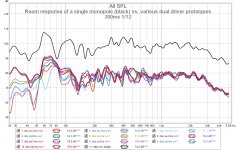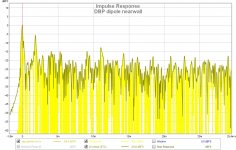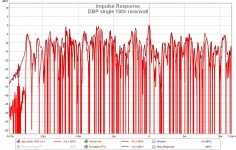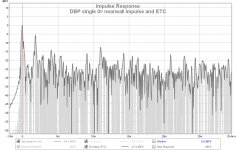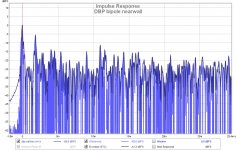Set three - farfield with speaker 1m to a corner in the wall
Measuring distance roughly 2m, 300ms IR gating used. This is what we usually see as room response with REW or RTA. 1/6 smoothing hides very small deviations caused by multiple order interferences. One graph also with 20ms gating.
We see that monopole, dipole and cardioid response below 200Hz make big dramatic changes. But if EQ is used to compensate for the biggest whoops, who can tell which is best? I didn't have time to listen to music, hopefully tomorrow...
Measuring distance roughly 2m, 300ms IR gating used. This is what we usually see as room response with REW or RTA. 1/6 smoothing hides very small deviations caused by multiple order interferences. One graph also with 20ms gating.
We see that monopole, dipole and cardioid response below 200Hz make big dramatic changes. But if EQ is used to compensate for the biggest whoops, who can tell which is best? I didn't have time to listen to music, hopefully tomorrow...
Attachments
-
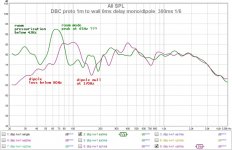 dbc proto 1mwall mono vs dipole 0ms delay 300ms 16 txt.jpg154.8 KB · Views: 249
dbc proto 1mwall mono vs dipole 0ms delay 300ms 16 txt.jpg154.8 KB · Views: 249 -
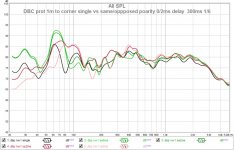 dbc proto 1mwall single same opppo 0 vs 2ms delay 300ms 16.jpg103.2 KB · Views: 236
dbc proto 1mwall single same opppo 0 vs 2ms delay 300ms 16.jpg103.2 KB · Views: 236 -
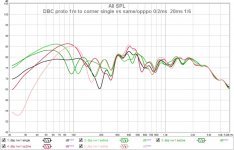 dbc proto 1mwall single same opppo 0 vs 2ms delay 20ms 16.jpg102.6 KB · Views: 241
dbc proto 1mwall single same opppo 0 vs 2ms delay 20ms 16.jpg102.6 KB · Views: 241 -
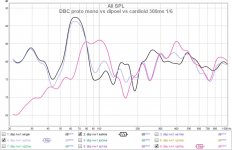 dbc proto 1mwall mono vs dipole vs cardioid 300ms 16.jpg90.3 KB · Views: 244
dbc proto 1mwall mono vs dipole vs cardioid 300ms 16.jpg90.3 KB · Views: 244 -
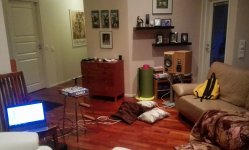 dbproto nearwall1 setup.jpg205.7 KB · Views: 238
dbproto nearwall1 setup.jpg205.7 KB · Views: 238
Last edited:
So, here first set
Monopole vs Dipole vs Cardioid nearfield 6ms IR-gating 0/180¤
In-room nearfield technique, same setup only dsp parameters changed.
Monopole - single frontfire driver
Dipole - double with opposite polarity on rearside (op)
Cardioid - double with same polarity and 2ms delay on rearside (sa)
We see that different patterns work only below 200Hz, then comb filtering takes over
Sorry I noticed a sort of a mistake in definitions
I tested both monopole (single frontfire driver) and a bipole/omni with two opposing drivers in same polarity (without delay - sa0ms)
A single monopole speaker has less radiated power on the backside always and more above the baffle step frequency. A bipole has almost full omnispheric even radiation below baffle step, and rather good even above it depending on box shape and dimensions.
When we add delay to the rearside driver the system gradually comes close to cardioid/hypercardioid (when polarity is same) I will try to get off-axis polar measurements today, yesterday was only front/90/180 degrees (90¤ not published)
^Please read the opening post, what Beolab and Kii are doing. DSP gives possibility to time-alignment and adjusting directivity and to correct the room response. Resistance-side ported cabinet is fixed with certain dimensions and performance.
I am not a fan of cardioids for home hifi. I just want to know how they work in real life/domestic environment. I have seen "too many" superlatives about their benefits
I am not a fan of cardioids for home hifi. I just want to know how they work in real life/domestic environment. I have seen "too many" superlatives about their benefits
You shouldn't delay the rear channel but the front. I would position the speakers back to back. Maximum effect @ a distance between the two woofers of 1/4 wavelength, with 1/4 period advancement of the rear driver.
In other words, for optimum effect at 80Hz, the drivers should be spaced about 1 meter apart, and the rear driver would need to be advanced by 3.125 ms. It would still work if you space the drivers .5 meters apart, but in that case the rear driver has to be advanced more.
In other words, for optimum effect at 80Hz, the drivers should be spaced about 1 meter apart, and the rear driver would need to be advanced by 3.125 ms. It would still work if you space the drivers .5 meters apart, but in that case the rear driver has to be advanced more.
Last edited:
^I made many measurements both ways - I must study them more and redo some measurements. I will take better polars hopefully today before the wife comes back from a business trip!
First test was with speakers back to back, but a 80cm deep speaker is quite demanding to be positioned in a living room. It would be too easy to make a PA outdoor stages-size cardioid!
Prototypes of Beolab 90 here B&O Tech: BeoLab 90 – Behind the scenes – earfluff and eyecandy and Beolab 50 B&O Tech: BeoLab 50 Design – earfluff and eyecandy
AXYS Beam Shaping Subwoofers | LIVE-PRODUCTION.TV
First test was with speakers back to back, but a 80cm deep speaker is quite demanding to be positioned in a living room. It would be too easy to make a PA outdoor stages-size cardioid!
Prototypes of Beolab 90 here B&O Tech: BeoLab 90 – Behind the scenes – earfluff and eyecandy and Beolab 50 B&O Tech: BeoLab 50 Design – earfluff and eyecandy
AXYS Beam Shaping Subwoofers | LIVE-PRODUCTION.TV
Last edited:
Some conclusions
Today I took 60 measurements of the proto with different dsp settings, polars in nearfield and room response measurements. I don't have enough time to finish polar graphics, but here are all farfield measurements in one picture.
Speakers positioned 1 meter (3') from a corner, mic distance 2m. Here IR gating 300ms and 1/12 smoothing. A single monopole speaker also measured, response curve lifted 20dB (black line)
I can't say which is best, this kind of dual bass driver-dsp system is not worth the effort in my opinion. When I listened to these, all dual systems sounded quite similar, lively and resonant sound, same everywhere in the room. This effect can be created without dsp, by using a dipole or omnispheric bass unit(s). The single driver speaker sounded totally different - the speaker was easily located in space and it's sound changed a lot when I moved around in the room.
One remarkable phenomenom is that with basically dipole systems (without dipole eq), the bass was not missing! This is because the reflected sound has same polarity as the direct sound in bass wavelengths -additive interference! Because of this, typical wide baffle dipoles work so well in normal rooms, despite of how they measure in free space.
Also, the 81Hz dip of a single speaker is missing from all other measurements! Instead of it, all dual systems exhibit a dip at 135Hz.
Today I took 60 measurements of the proto with different dsp settings, polars in nearfield and room response measurements. I don't have enough time to finish polar graphics, but here are all farfield measurements in one picture.
Speakers positioned 1 meter (3') from a corner, mic distance 2m. Here IR gating 300ms and 1/12 smoothing. A single monopole speaker also measured, response curve lifted 20dB (black line)
I can't say which is best, this kind of dual bass driver-dsp system is not worth the effort in my opinion. When I listened to these, all dual systems sounded quite similar, lively and resonant sound, same everywhere in the room. This effect can be created without dsp, by using a dipole or omnispheric bass unit(s). The single driver speaker sounded totally different - the speaker was easily located in space and it's sound changed a lot when I moved around in the room.
One remarkable phenomenom is that with basically dipole systems (without dipole eq), the bass was not missing! This is because the reflected sound has same polarity as the direct sound in bass wavelengths -additive interference! Because of this, typical wide baffle dipoles work so well in normal rooms, despite of how they measure in free space.
Also, the 81Hz dip of a single speaker is missing from all other measurements! Instead of it, all dual systems exhibit a dip at 135Hz.
Attachments
Last edited:
Some conclusions
Today I took 60 measurements of the proto with different dsp settings, polars in nearfield and room response measurements. I don't have enough time to finish polar graphics, but here are all farfield measurements in one picture.
Speakers positioned 1 meter (3') from a corner, mic distance 2m. Here IR gating 300ms and 1/12 smoothing. A single monopole speaker also measured, response curve lifted 20dB (black line)
I can't say which is best, this kind of dual bass driver-dsp system is not worth the effort in my opinion. When I listened to these, all dual systems sounded quite similar, lively and resonant sound, same everywhere in the room. This effect can be created without dsp, by using a dipole or omnispheric bass unit(s). The single driver speaker sounded totally different - the speaker was easily located in space and it's sound changed a lot when I moved around in the room.
One remarkable phenomenom is that with basically dipole systems (without dipole eq), the bass was not missing! This is because the reflected sound has same polarity as the direct sound in bass wavelengths -additive interference! Because of this, typical wide baffle dipoles work so well in normal rooms, despite of how they measure in free space.
Also, the 81Hz dip of a single speaker is missing from all other measurements! Instead of it, all dual systems exhibit a dip at 135Hz.
Could you say why you don't show the CSD instead of 2D graphs please ?
It is my only way to equalize and place my loudspeakers and i can't see anything with simple FR graphs.
I am not a fan of cardioids for home hifi. I just want to know how they work in real life/domestic environment. I have seen "too many" superlatives about their benefits
Call me then a fan of an uniform dispersion over the whole audio frequency band.
I'm listening to some jazz at the moment with my dipole set up and thinking, if the bass player was in my room now how would the sound be radiating from his instrument?
But he is not! That's the point. You are getting 2 channels that suppose to fool your imagination as if it is one, and exactly on the place where you hear it! Also, there is reverberation recorder, that should not be mixed improperly with you room's reverberation confusing your imagination! That's why dipoles sound so good in real rooms.
Eh? That sounds contradictory to meAlso, there is reverberation recorder, that should not be mixed improperly with you room's reverberation confusing your imagination! That's why dipoles sound so good in real rooms.
Did you run some sort of xo to rear facing speaker or played fullrange?
Similar response to both drivers and similar spl. EQ to straighten the free-air response of a smallish closed cabinet - baffle step compensation basically.
Nearwall spl, IR and ETC of single , bipole and dipole radiators
I set different IR gating to previously shown room response measurements, so we can see how various reflections work for each type of sytems. Speaker(pair) nd mic location same in all measurements. Speaker 1m from a cormer in wall, mic distance roughly 2,2 meters.
These don't include any dsp-delays or dipole corrections.
Looks to me that the dipole system's response (Yellow) is smoothest, if we just made dipole-typical eq for it. Naturally low end distortion and spl capacity would become problematic for a 6,5" driver.
180¤ turned, backwards radiating monopole/single driver shows highest impulse peak at 22ms!
I set different IR gating to previously shown room response measurements, so we can see how various reflections work for each type of sytems. Speaker(pair) nd mic location same in all measurements. Speaker 1m from a cormer in wall, mic distance roughly 2,2 meters.
These don't include any dsp-delays or dipole corrections.
Looks to me that the dipole system's response (Yellow) is smoothest, if we just made dipole-typical eq for it. Naturally low end distortion and spl capacity would become problematic for a 6,5" driver.
180¤ turned, backwards radiating monopole/single driver shows highest impulse peak at 22ms!
Attachments
SPL responses
Attachments
-
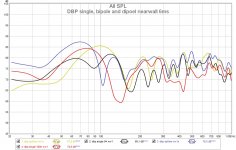 dbp nearwall1 single 0 180 vs bipole vs dipole 6ms 112.jpg147.1 KB · Views: 158
dbp nearwall1 single 0 180 vs bipole vs dipole 6ms 112.jpg147.1 KB · Views: 158 -
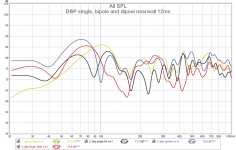 dbp nearwall1 single 0 180 vs bipole vs dipole 12ms 112.jpg149.7 KB · Views: 43
dbp nearwall1 single 0 180 vs bipole vs dipole 12ms 112.jpg149.7 KB · Views: 43 -
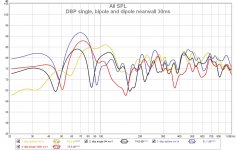 dbp nearwall1 single 0 180 vs bipole vs dipole 30ms 112.jpg151.3 KB · Views: 35
dbp nearwall1 single 0 180 vs bipole vs dipole 30ms 112.jpg151.3 KB · Views: 35 -
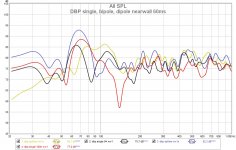 dbp nearwall1 single 0 180 vs bipole vs dipole 60ms 112.jpg152.1 KB · Views: 31
dbp nearwall1 single 0 180 vs bipole vs dipole 60ms 112.jpg152.1 KB · Views: 31 -
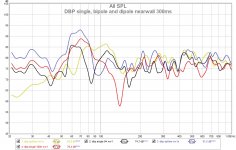 dbp nearwall1 single 0 180 vs bipole vs dipole 300ms 112.jpg153.9 KB · Views: 39
dbp nearwall1 single 0 180 vs bipole vs dipole 300ms 112.jpg153.9 KB · Views: 39
Some conclusions
Today I took 60 measurements of the proto with different dsp settings, polars in nearfield and room response measurements. I don't have enough time to finish polar graphics, but here are all farfield measurements in one picture.
Speakers positioned 1 meter (3') from a corner, mic distance 2m. Here IR gating 300ms and 1/12 smoothing. A single monopole speaker also measured, response curve lifted 20dB (black line)
I can't say which is best, this kind of dual bass driver-dsp system is not worth the effort in my opinion. When I listened to these, all dual systems sounded quite similar, lively and resonant sound, same everywhere in the room. This effect can be created without dsp, by using a dipole or omnispheric bass unit(s). The single driver speaker sounded totally different - the speaker was easily located in space and it's sound changed a lot when I moved around in the room.
One remarkable phenomenom is that with basically dipole systems (without dipole eq), the bass was not missing! This is because the reflected sound has same polarity as the direct sound in bass wavelengths -additive interference! Because of this, typical wide baffle dipoles work so well in normal rooms, despite of how they measure in free space.
Also, the 81Hz dip of a single speaker is missing from all other measurements! Instead of it, all dual systems exhibit a dip at 135Hz.
IMHO, a Geddes multiple sub setup is really tough to beat. I've tinkered with so many audio projects, but multi-sub is one of those things I don't tinker with. It...just...works.
For directivity control, waveguides are optimum, imho. You can get directivity control using arrays, but waveguides work better.
But waveguides get big in a hurry.
For that reason, I think directivity control via arrays is a compelling option for the two octaves from 200Hz to 800Hz. Basically there's a viable solution for low frequencies (multisub) and a viable solution for high frequencies (waveguides), but those two octaves don't have a really obvious solution.
Some might suggest going dipole for that range, but that creates it's own set of problems because you wind up with a directivity mis-match to the waveguide.
Looks to me that the dipole system's response (Yellow) is smoothest, if we just made dipole-typical eq for it.
...and since ears hear differently from microphones that capture the mix in the point and can't distinguish sounds from different directions, this difference is even bigger than the microphone shows.
What advantage does cardioid have over dipole in room?
Less power loss, but still better sound than with a closed box speaker?
3 years ago I already bought 16 of 8" long throw drivers for cardioid arrays, but still can't get back to that project... I am drooling when thinking about it...
Last edited:
- Status
- This old topic is closed. If you want to reopen this topic, contact a moderator using the "Report Post" button.
- Home
- Loudspeakers
- Multi-Way
- Bass beam control with dsp
